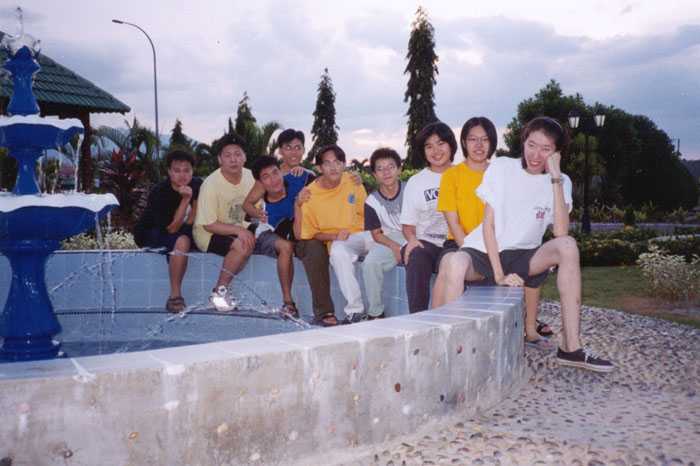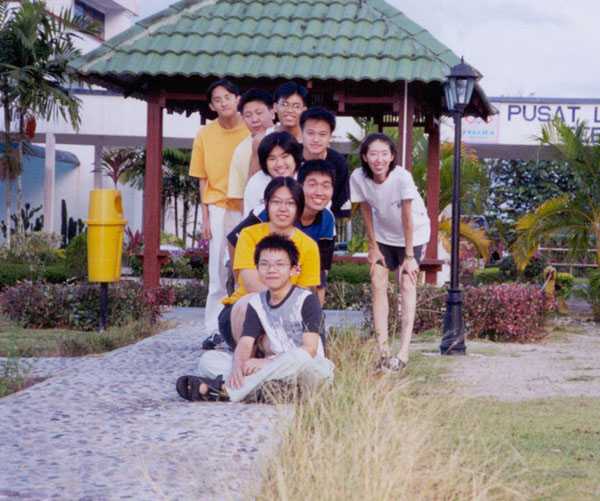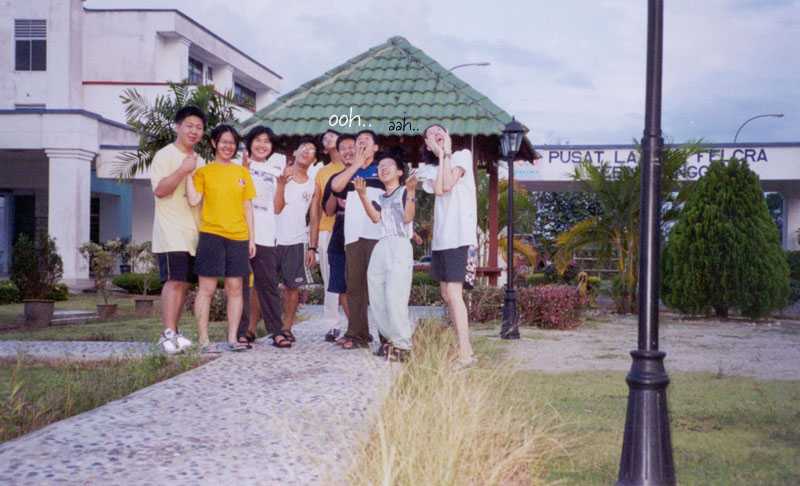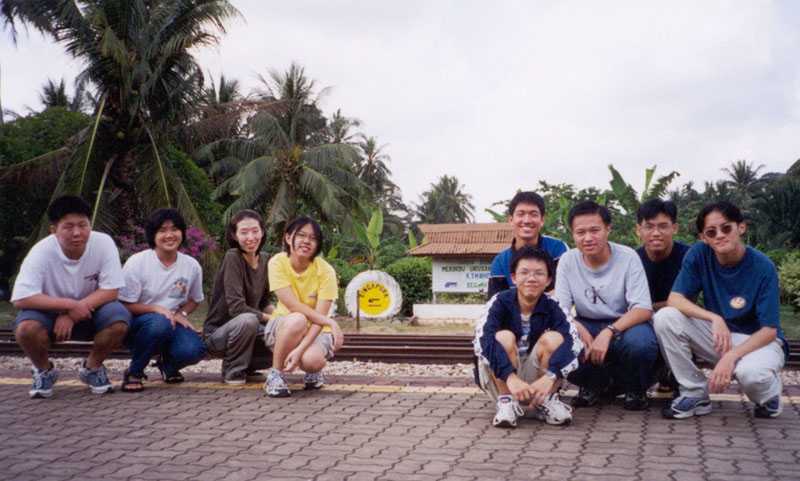5
am. Organization fear. Logistical nightmare. Bad
weather. Murphy's Law. Malaysian customs had changed
their declaration form for the fifth time on 9th
March. More than enough to keep me up thinking of
what else might go wrong. By the time I got to sleep,
it was about time to leave for the station.
7.40am
: Everyone's ready and waiting at the Tanjong Pagar
Station. There would be 9 of us from Singapore. As it
turns out, while March might be one of the best times
to go stellar hunting, many students had to return to
their college mid-term exams after the holiday week.
Bummer.
These
are the braver ones who would choose the stars over
their exams.
Customs
check. I had suffocated my GP-D mount under a
deliberate artful mess of clothes in my backpack; WYO
scope on one hand, the Vixen HAL tripod in another.
As I expected, I got detained while the officials
checked out the FluoroStar. They had their suspicions
that it was a telescope capable of far more than just
a mere telephotographing. Fortunately, I had pasted a
huge Canon sticker over the aluminium case, and a
smaller Canon Sticker over the WYO logo on the
FluoroStar. They checked if the brand was
non-dutiable before releasing me.
Back
to the group. It wasn't long before they got
comfortable with each other card-playing "tai
di" & bridge. Being their first train ride,
there were a couple of pointers they weren't aware
of. One was the customs check protocol of "Quick
= No Need to Wait in Queue." The other was the
alighting procedure upon reaching destination
Segamat. I was fraught with anxiety that one of them
might just get left behind on the train.

12.15pm
Segamat. There was a slight delay at the tracks. We
were met at the station by Vincent. Two taxis were
catered for the transfer to Felcra. Upon arrival, we
checked in to rooms 217, 219 & 221 on the third
floor. Lunch was a little late at 2pm. Free time. I
dropped into bed after making sure that everyone was
fine and settled.
Being
a small group gave us the luxury of deciding when we
would like to do what. We didn't exactly follow the
planned schedule. Turned out that a couple of us (me
included) were in need of afternoon naps. But in the
spirit of astronomy, we were all up at 6.30pm for an
introductory course in star-hopping and constellation
mapping.
8pm,
a slight drizzle but nothing more damaging. Venus
hung low in the West sky. Jupiter and Saturn are
still in Taurus. Orion was overhead. Mr Au arrived
from Singapore to join us. Mr Au and I set up our
equipment on the main carpark and pretty much stayed
there for the night.
We
had our dinner at 9pm. At about 9.30pm, a group of 8
arrived from the Segamat Teochew Association to join
us for a few hours of observation. The first night
was pretty relaxed. A couple of low clouds flitting
in between the stars. Mr Au had plenty of stories to
share with everyone.
We
had a glimpse of Jupiter and Saturn. M42 Nebula in
Orion. M45 Pleiades in Taurus. NGC 2237 Rosette. NGC
2264 Christmas Tree cluster. Etc. Our first night was
pretty much free & easy. We hopped around to any
objects that came to our minds.
M104
Sombrero Galaxy near Corvus. One of Mr Au's personal
favourites. There was a thin layer of atmospheric
obstruction. We took turns to search out the object.
It wasn't easy. Finally after 30 minutes of sheer eye
strain from both of us, I spotted the ghostly glow
emanating from the dark central lane. Very NICE! To
think that it was there all this time, and we just
couldn't figure out why we weren't seeing it. Light
pollution was very mild, I would hazard a guess about
atmospheric clarity for the difficulty in seeing
M104. Lijie and Xiaoqi tried really hard to glimpse
this elusive galaxy. Their attempts were swathed by
thin cloud layers, unfortunately decreasing overall
brightness of the low magnitude object.
2am,
clouds had fogged out the stars. The Moon was out,
diffusing its light from behind the clouds. We called
it a night. Most of them were already off to
dreamland. But not bad for their first night under
the stars.
7am,
the campers were up and ready for breakfast. This was
the first in a series of 6 meals (7am, 10am, 1pm,
3.30pm, 7pm, 10pm). *lol!* I think there was general
fear of more food today. After breakfast, we dropped
back into bed, waking up to lunch at about 1.45pm.
After lunch, we dropped back into bed, lazing around
so to speak. An hour later, we congregated
comfortably in one dorm to expound some ideas and
concepts on astronomy.
7pm,
dinner, and a session on observation planning before
starting out tonight. This being our last night, we
had minimum time to do maximum cosmic hunting. Each
of us took on at least one constellation, combing out
all the NGC-IC-M objects. The list is impressive. Now
the hunt begins.
9pm,
we were joined by two teachers who had heard about
our session at Felcra. Vincent had drove up with his
SkySensor unit and scope. Thin clouds soon dispersed,
unveiling a nice canopy of stars which became loads
clearer when we switched off all the lights at
Felcra. 3-point alignments and we were zooming in on
stellar treasure troves.
:)
SkySensor units on both sides, we pretty much covered
the entire universe that night. It made the stars so
accessible to the campers. Star clusters were
plentiful, as were the number of galaxies. Faint
structures could be discerned to the keener eyes, and
with seasoned averted visions. The good news then was
that some of them managed to finally see M104 in
Corvus. I was personally having a field day (night).
It was hard not to appreciate the clear skies that we
had at Felcra, even if the waning quarter Moon did
wash out a lot of the skies after it rose at 1am.
We
panned across the lunar surface, crater hunting. The
features were sharp, shadows drew long over the lunar
mountains into the valleys. A couple of Felcra
management trainees joined us then. The Moon was
fascinating to say the least.
But
the best is yet to come. That also meant that Mars
was out. At 150x, it resolved nicely into a faint
orange globe with a prominent white polar cap on the
southern end. It wasn't a uniform sort of orange,
there were some slightly darker markings. I'm wishing
now that I'd logged in more time to observe this
planet.
3.30am,
after all that cruising around the universe, the
battery finally ran out. I'm personally quite
satisfied at the amount of objects that we'd managed
to clock together. I'm just thankful there was no
serious cloud injury to the second night's
observation.
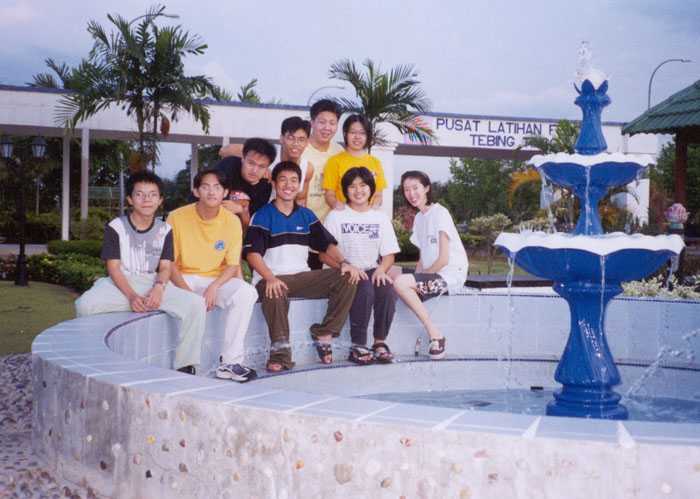
Thanks
for the espirit de camp,
everyone! I had a really nice time. I'm really
appreciative of the help that everyone offered. The
Camp would not have been what it is, had you all been
too reserved. Glad that none of you are too coy or
shy to get a little crazy down at Camp. :)
Special
thanks to Mr Au, Vincent and Sua for dropping by.
By
Lin . 20th March 2001, Tuesday.

